Research on Digital Twin Method for Spaceborne Along-Track Interferometric Synthetic Aperture Radar Velocity Inversion of Ocean Surface Currents
Abstract
:1. Introduction
2. Construction of Digital Twin System for Spaceborne ATI-SAR Ocean Surface Current Inversion
2.1. Three-Dimensional Ocean Surface Modeling System
2.2. Spaceborne ATI-SAR Time-Varying Ocean Surface Echo Simulation System
2.3. Ocean Surface Current Fitting Inversion System
2.3.1. Basic Theory Module
2.3.2. M4S-Based Iteration Module
2.3.3. DT-Based Optimization Module
3. Simulation Experiment and Analysis of Results
3.1. Antenna Configuration and System Parameters
3.2. Simulation Outcomes and Analysis
4. Conclusions and Discussion
Author Contributions
Funding
Data Availability Statement
Conflicts of Interest
References
- Elyouncha, A.; Eriksson, L.E.B.; Romeiser, R.; Ulander, L.M.H. Measurements of Sea Surface Currents in the Baltic Sea Region Using Spaceborne Along-Track InSAR. IEEE Trans. Geosci. Remote Sens. 2019, 57, 8584–8599. [Google Scholar] [CrossRef]
- Vachon, W. Current measurement by Lagrangian drifting buoys-problems and potential. In Proceedings of the OCEANS’77 Conference Record, Los Angeles, CA, USA, 17 October 1977; pp. 639–645. [Google Scholar]
- Kovačević, V.; Gačić, M.; Poulain, P.M. Eulerian current measurements in the Strait of Otranto and in the Southern Adriatic. J. Mar. Syst. 1999, 20, 255–278. [Google Scholar] [CrossRef]
- Moreira, A.; Prats-Iraola, P.; Younis, M.; Krieger, G.; Hajnsek, I.; Papathanassiou, K.P. A tutorial on synthetic aperture radar. IEEE Geosci. Remote Sens. Mag. 2013, 1, 6–43. [Google Scholar] [CrossRef]
- Goldstein, R.M.; Zebker, H. Interferometric radar measurement of ocean surface currents. Nature 1987, 328, 707–709. [Google Scholar] [CrossRef]
- Thompson, D.R.; Jensen, J. Synthetic aperture radar interferometry applied to ship-generated internal waves in the 1989 Loch Linnhe experiment. J. Geophys. Res. Ocean. 1993, 98, 10259–10269. [Google Scholar] [CrossRef]
- Graber, H.C.; Thompson, D.R.; Carande, R.E. Ocean surface features and currents measured with synthetic aperture radar interferometry and HF radar. J. Geophys. Res. Ocean. 1996, 101, 25813–25832. [Google Scholar] [CrossRef]
- Romeiser, R. Current measurements by airborne along-track InSAR: Measuring technique and experimental results. IEEE J. Ocean. Eng. 2005, 30, 552–569. [Google Scholar] [CrossRef]
- Toporkov, J.V.; Perkovic, D.; Farquharson, G.; Sletten, M.A.; Frasier, S.J. Sea surface velocity vector retrieval using dual-beam interferometry: First demonstration. IEEE Trans. Geosci. Remote Sens. 2005, 43, 2494–2502. [Google Scholar] [CrossRef]
- Romeiser, R.; Suchandt, S.; Runge, H.; Steinbrecher, U.; Grunler, S. First analysis of TerraSAR-X along-track InSAR-derived current fields. IEEE Trans. Geosci. Remote Sens. 2009, 48, 820–829. [Google Scholar] [CrossRef]
- Weydahl, D.; Sagstuen, J.; Dick, Ø.; Rønning, H. SRTM DEM accuracy assessment over vegetated areas in Norway. Int. J. Remote Sens. 2007, 28, 3513–3527. [Google Scholar] [CrossRef]
- Zhang, B.; Perrie, W.; Li, X.; Pichel, W.G. Mapping sea surface oil slicks using RADARSAT-2 quad-polarization SAR image. Geophys. Res. Lett. 2011, 38. [Google Scholar] [CrossRef]
- Qingjun, Z. System design and key technologies of the GF-3 satellite. Acta Geod. Et Cartogr. Sin. 2017, 46, 269. [Google Scholar]
- Romeiser, R.; Thompson, D.R. Numerical study on the along-track interferometric radar imaging mechanism of oceanic surface currents. IEEE Trans. Geosci. Remote Sens. 2000, 38, 446–458. [Google Scholar] [CrossRef]
- Romeiser, R.; Runge, H. Theoretical evaluation of several possible along-track InSAR modes of TerraSAR-X for ocean current measurements. IEEE Trans. Geosci. Remote Sens. 2006, 45, 21–35. [Google Scholar] [CrossRef]
- Romeiser, R.; Runge, H.; Suchandt, S.; Kahle, R.; Rossi, C.; Bell, P.S. Quality assessment of surface current fields from TerraSAR-X and TanDEM-X along-track interferometry and Doppler centroid analysis. IEEE Trans. Geosci. Remote Sens. 2013, 52, 2759–2772. [Google Scholar] [CrossRef]
- Romeiser, R.; Runge, H.; Suchandt, S.; Sprenger, J.; Weilbeer, H.; Sohrmann, A.; Stammer, D. Current measurements in rivers by spaceborne along-track InSAR. IEEE Trans. Geosci. Remote Sens. 2007, 45, 4019–4031. [Google Scholar] [CrossRef]
- Mittermayer, J.; Alberga, V.; Buckreuss, S.; Riegger, S. TerraSAR-X: Predicted performance. In Proceedings of the Sensors, Systems, and Next-Generation Satellites VI, SPIE, Barcelona, Spain, 8–10 September 2003; Volume 4881, pp. 244–255. [Google Scholar]
- Mittermayer, J.; Runge, H. Conceptual studies for exploiting the TerraSAR-X dual receive antenna. In Proceedings of the IGARSS 2003, 2003 IEEE International Geoscience and Remote Sensing Symposium, Proceedings (IEEE Cat. No. 03CH37477), Toulouse, France, 21–25 July 2003; Volume 3, pp. 2140–2142. [Google Scholar]
- Kahle, R.; Runge, H.; Ardaens, J.S.; Suchandt, S.; Romeiser, R. Formation flying for along-track interferometric oceanography—First in-flight demonstration with TanDEM-X. Acta Astronaut. 2014, 99, 130–142. [Google Scholar] [CrossRef]
- Gini, F.; Lombardini, F. Multibaseline cross-track SAR interferometry: A signal processing perspective. IEEE Aerosp. Electron. Syst. Mag. 2005, 20, 71–93. [Google Scholar] [CrossRef]
- Grilli, S.T. Depth inversion in shallow water based on nonlinear properties of shoaling periodic waves. Coast. Eng. 1998, 35, 185–209. [Google Scholar] [CrossRef]
- Klemas, V. Remote sensing of ocean internal waves: An overview. J. Coast. Res. 2012, 28, 540–546. [Google Scholar] [CrossRef]
- Xu, Z.; Zhang, H.; Wang, Y.; Wang, X.; Xue, S.; Liu, W. Dynamic detection of offshore wind turbines by spatial machine learning from spaceborne synthetic aperture radar imagery. J. King Saud Univ.-Comput. Inf. Sci. 2022, 34, 1674–1686. [Google Scholar] [CrossRef]
- Tao, F.; Zhang, H.; Liu, A.; Nee, A.Y.C. Digital Twin in Industry: State-of-the-Art. IEEE Trans. Ind. Inform. 2019, 15, 2405–2415. [Google Scholar] [CrossRef]
- Rouffet, T.; Poisson, J.B.; Hottier, V.; Kemkemian, S. Digital twin: A full virtual radar system with the operational processing. In Proceedings of the 2019 International Radar Conference (RADAR), Toulon, France, 23–27 September 2019; pp. 1–5. [Google Scholar]
- Timoshenko, A.V.; Perlov, A.Y.; Kazantsev, A.M.; Khodataev, N.A.; Lvov, K.V. Methodology for the Development of a Digital Twin of Radar Stations of a Functional Block Structure. In Proceedings of the 2022 Systems of Signal Synchronization, Generating and Processing in Telecommunications (SYNCHROINFO), Arkhangelsk, Russia, 29 June–1 July 2022; pp. 1–4. [Google Scholar]
- Karboski, A.; Vivekanandan, J.; Burghart, C.; Eret, T. Airborne Polarimetric Doppler Phased Array Weather Radar: Digital Twin of the Active Electronically Scanned Array. In Proceedings of the 2022 IEEE International Symposium on Phased Array Systems and Technology (PAST), Waltham, MA, USA, 11–14 October 2022; pp. 1–6. [Google Scholar]
- Xie, W.; Qi, F.; Liu, L.; Liu, Q. Radar Imaging Based UAV Digital Twin for Wireless Channel Modeling in Mobile Networks. IEEE J. Sel. Areas Commun. 2023, 41, 3702–3710. [Google Scholar] [CrossRef]
- Grieves, M. Digital twin: Manufacturing excellence through virtual factory replication. White Pap. 2014, 1, 1–7. [Google Scholar]
- Neumann, G. On wind-generated wave motion at subsurface levels. Eos. Trans. Am. Geophys. Union 1955, 36, 985–992. [Google Scholar]
- Pierson, W.J., Jr.; Moskowitz, L. A proposed spectral form for fully developed wind seas based on the similarity theory of SA Kitaigorodskii. J. Geophys. Res. 1964, 69, 5181–5190. [Google Scholar] [CrossRef]
- Fung, A.; Lee, K. A semi-empirical sea-spectrum model for scattering coefficient estimation. IEEE J. Ocean. Eng. 1982, 7, 166–176. [Google Scholar] [CrossRef]
- Hasselmann, D.E.; Dunckel, M.; Ewing, J. Directional wave spectra observed during JONSWAP 1973. J. Phys. Oceanogr. 1980, 10, 1264–1280. [Google Scholar] [CrossRef]
- Elfouhaily, T.; Chapron, B.; Katsaros, K.; Vandemark, D. A unified directional spectrum for long and short wind-driven waves. J. Geophys. Res. Ocean. 1997, 102, 15781–15796. [Google Scholar] [CrossRef]
- Donelan, M.A.; Hamilton, J.; Hui, W. Directional spectra of wind-generated ocean waves. Philos. Trans. R. Soc. London. Ser. A Math. Phys. Sci. 1985, 315, 509–562. [Google Scholar]
- Longuet-Higgins, M.S. Observation of the directional spectrum of sea waves using the motions of a floating buoy. Oc. Wave Spectra 1963. [Google Scholar]
- Guinard, N.; Daley, J. An experimental study of a sea clutter model. Proc. IEEE 1970, 58, 543–550. [Google Scholar] [CrossRef]
- Mori, A.; De Vita, F. A time-domain raw signal simulator for interferometric SAR. IEEE Trans. Geosci. Remote Sens. 2004, 42, 1811–1817. [Google Scholar] [CrossRef]
- Wollstadt, S.; Lopez-Dekker, P.; De Zan, F.; Younis, M. Design principles and considerations for spaceborne ATI SAR-based observations of ocean surface velocity vectors. IEEE Trans. Geosci. Remote Sens. 2017, 55, 4500–4519. [Google Scholar] [CrossRef]
- Yegulalp, A.F. Fast backprojection algorithm for synthetic aperture radar. In Proceedings of the 1999 IEEE Radar Conference. Radar into the Next Millennium (Cat. No. 99CH36249), Waltham, MA, USA, 22 April 1999; pp. 60–65. [Google Scholar]
- Kim, D.J.; Moon, W.; Moller, D.; Imel, D. Measurements of ocean surface waves and currents using L- and C-band along-track interferometric SAR. IEEE Trans. Geosci. Remote Sens. 2003, 41, 2821–2832. [Google Scholar]
- Romeiser, R.; Breit, H.; Eineder, M.; Runge, H.; Flament, P.; De Jong, K.; Vogelzang, J. On the suitability of TerraSAR-X split antenna mode for current measurements by along-track interferometry. In Proceedings of the IGARSS 2003, 2003 IEEE International Geoscience and Remote Sensing Symposium, Proceedings (IEEE Cat. No. 03CH37477), Toulouse, France, 21–25 July 2003; Volume 2, pp. 1320–1322. [Google Scholar]
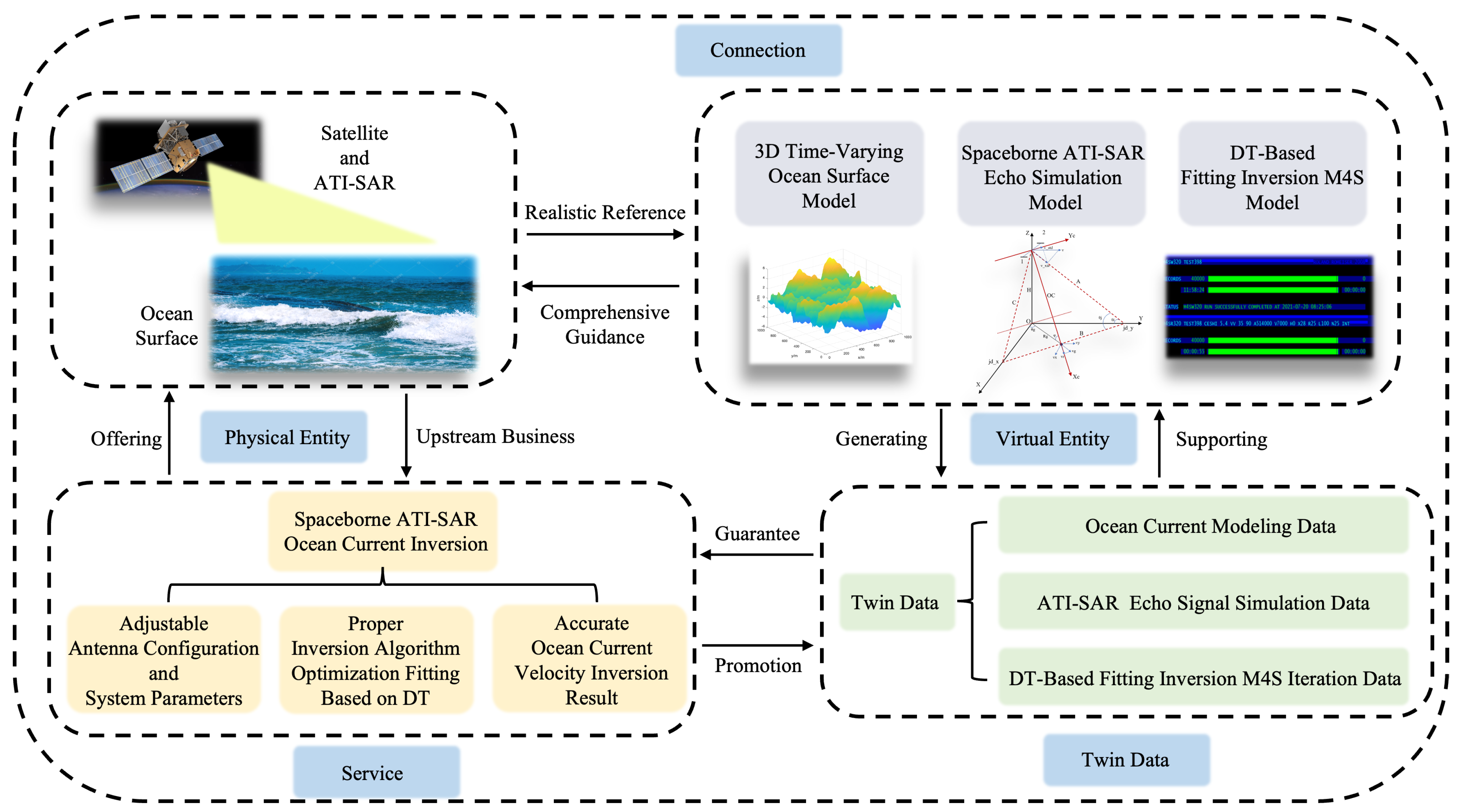
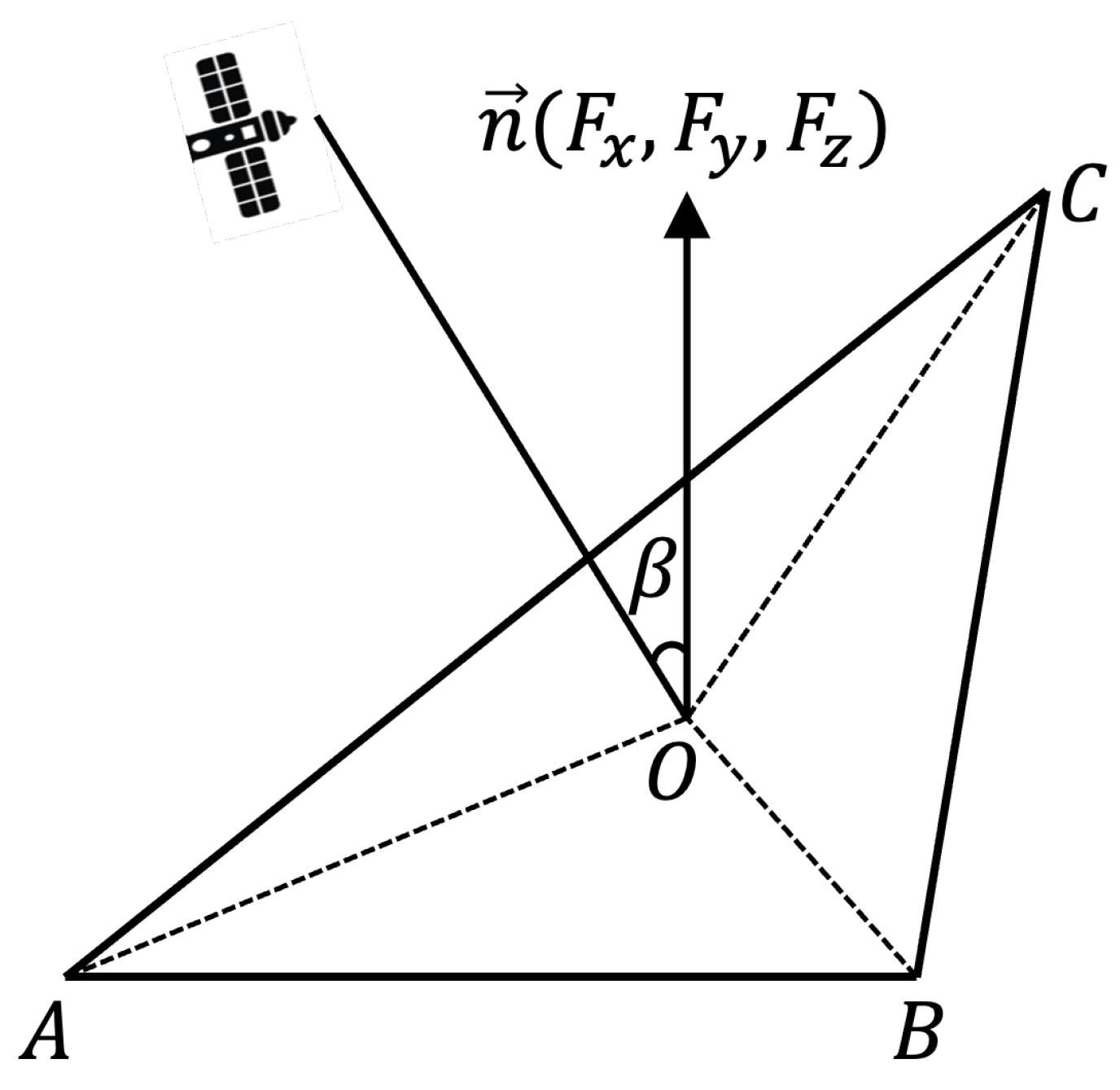
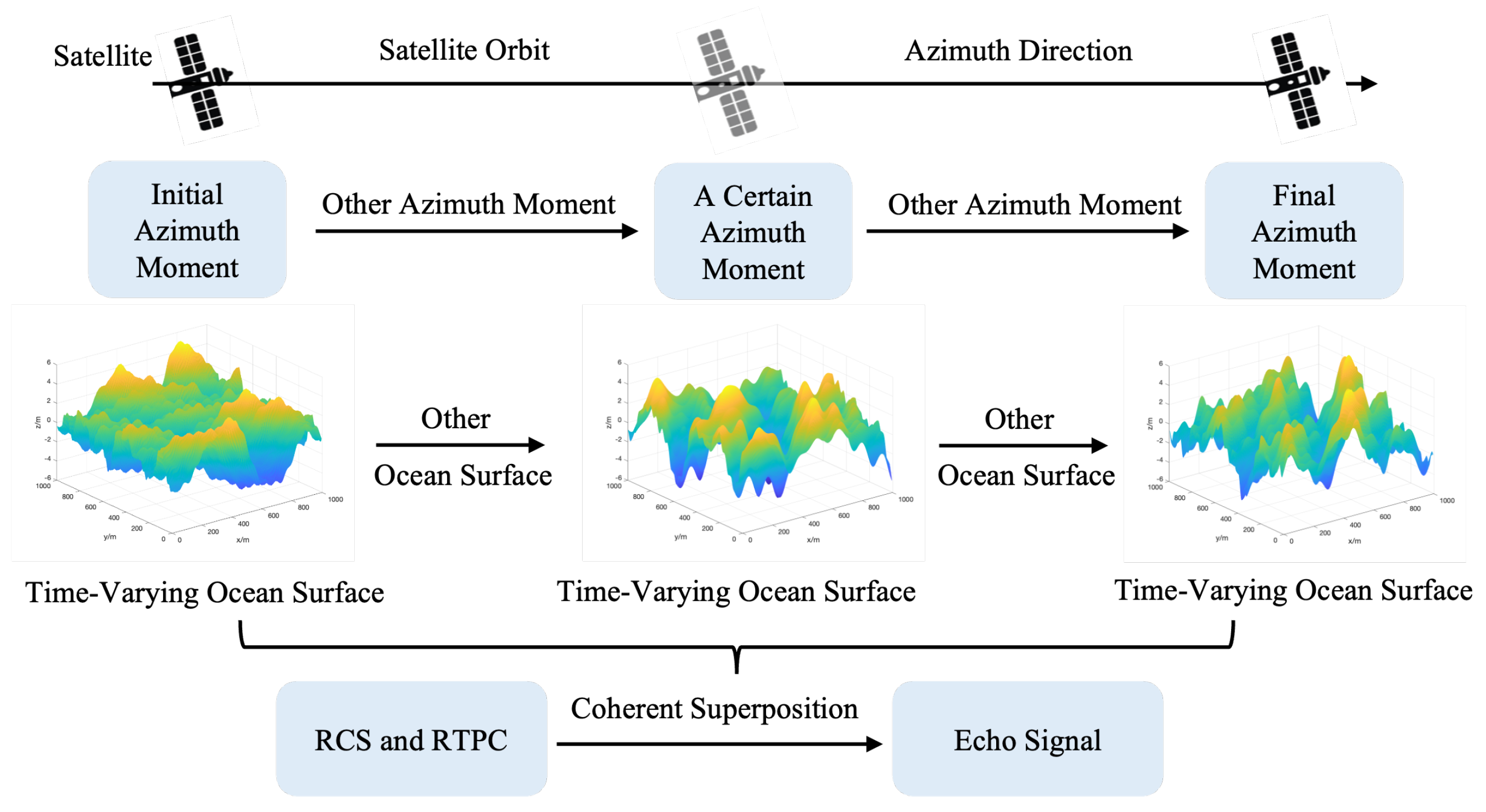
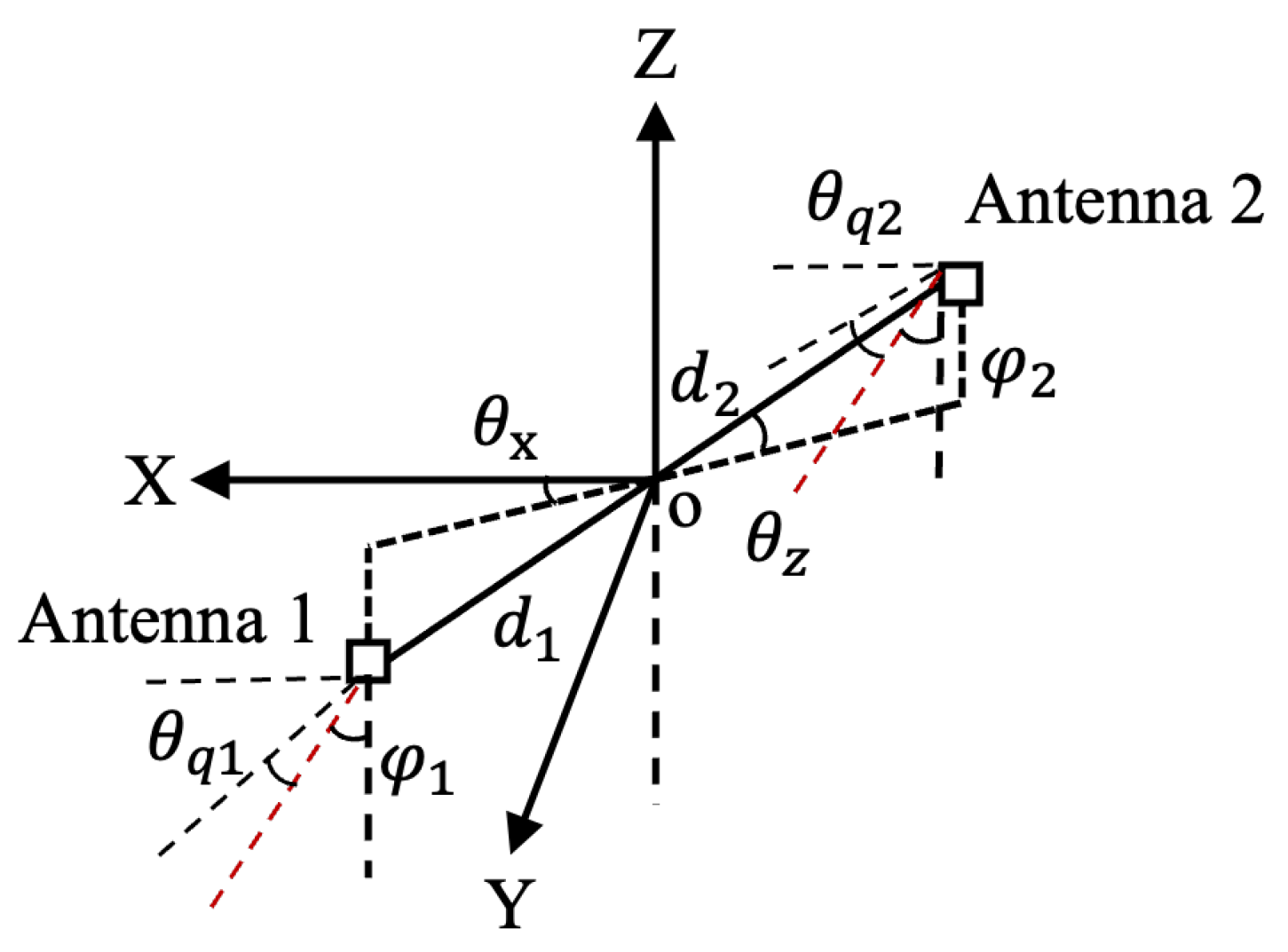

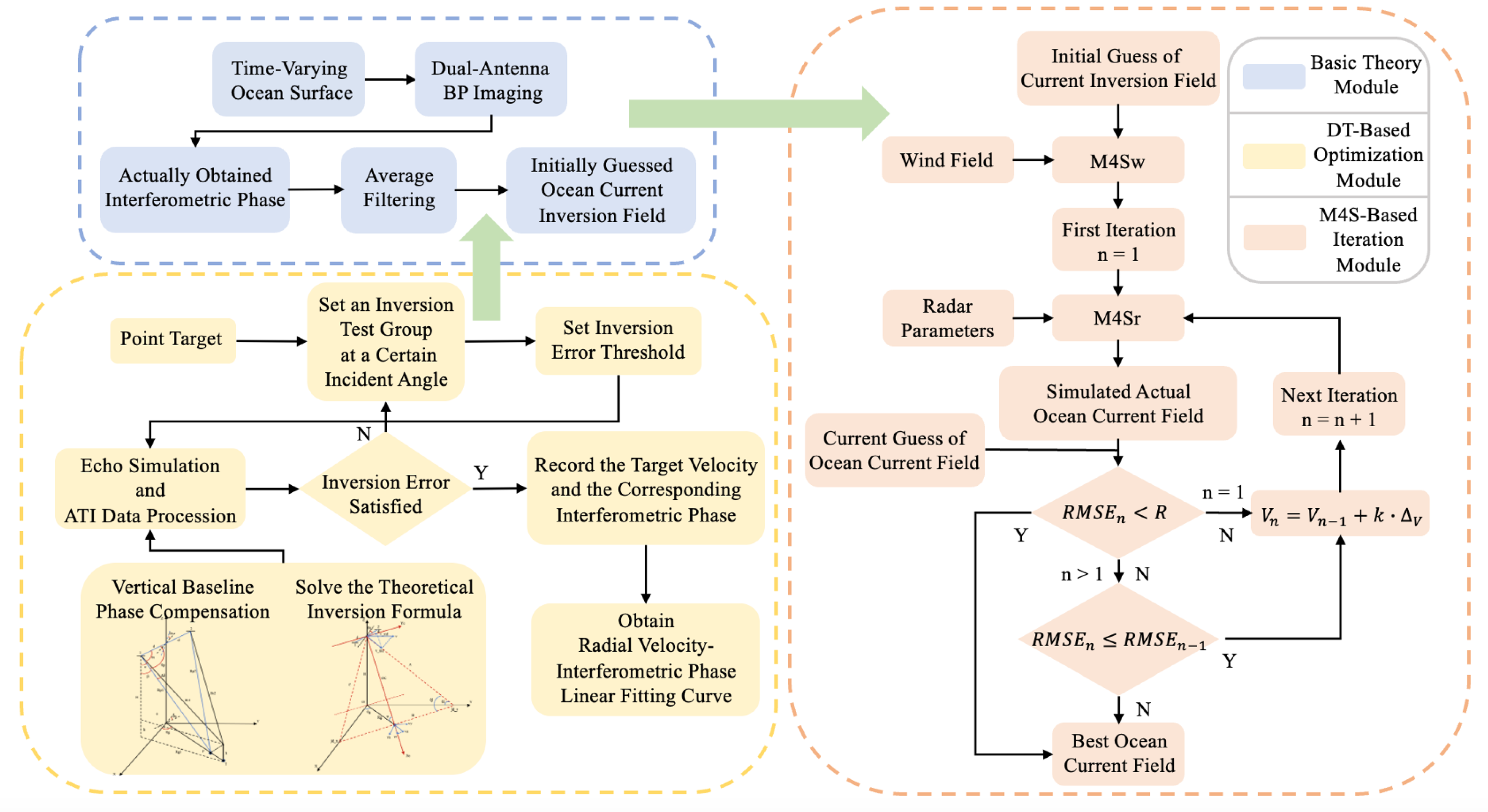

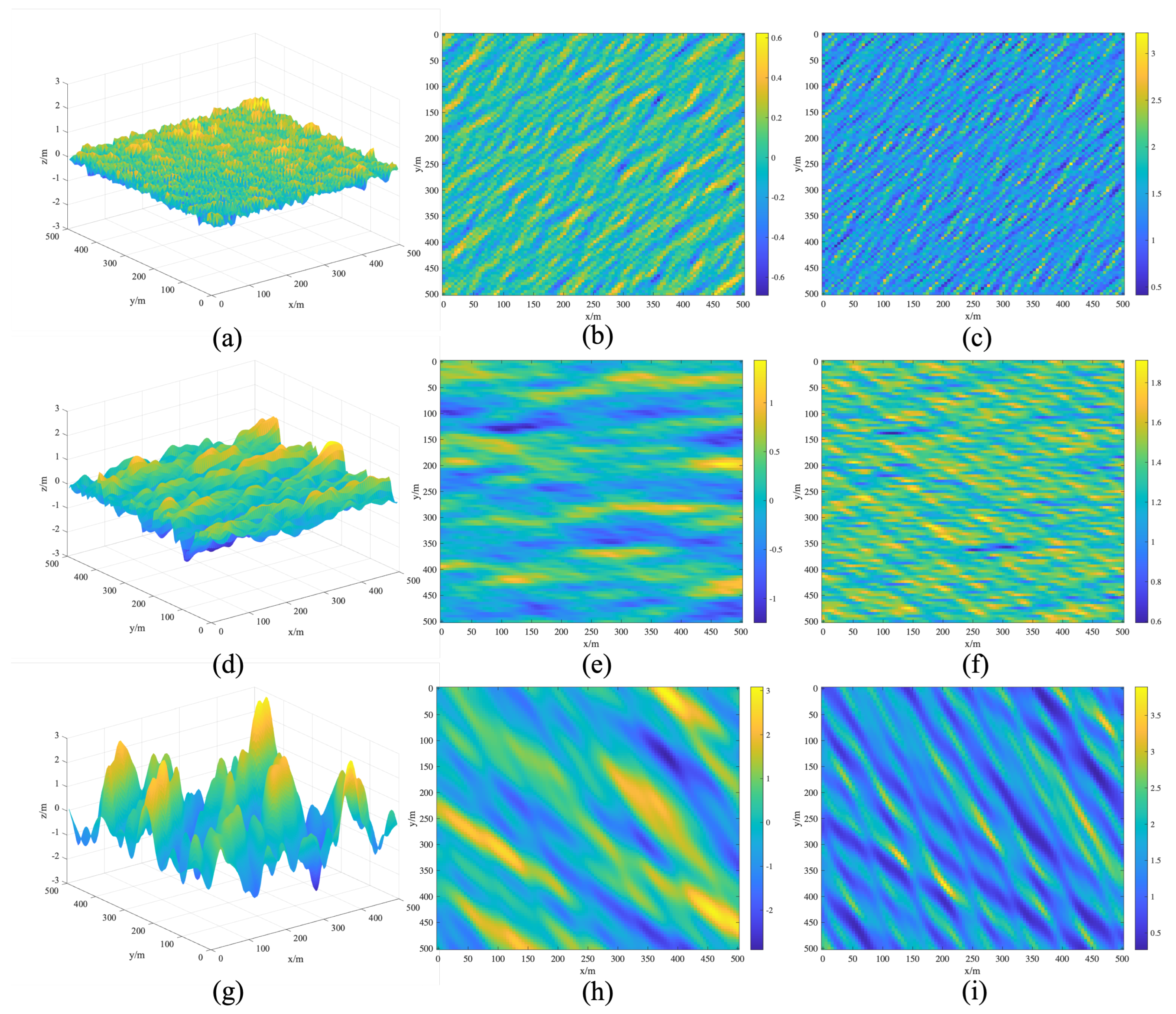

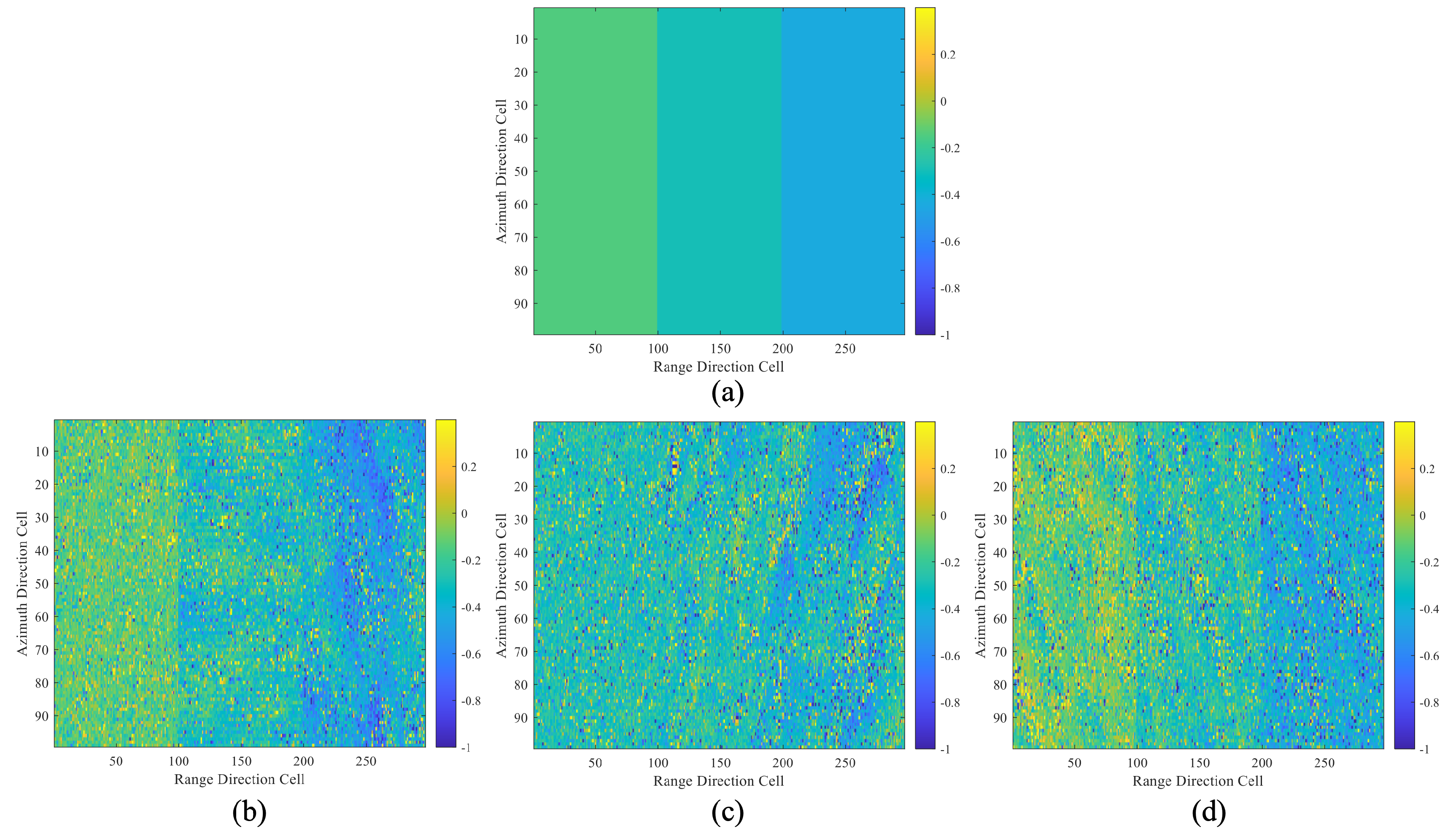

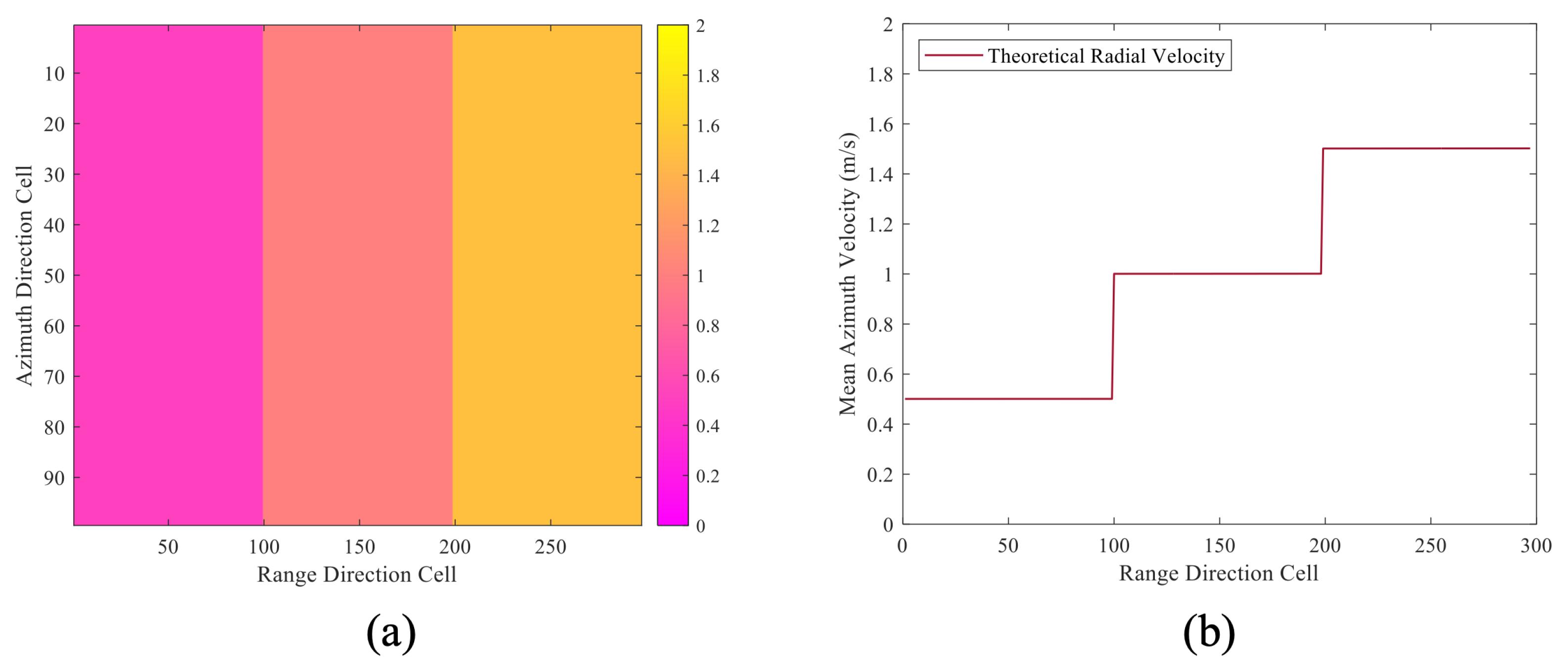
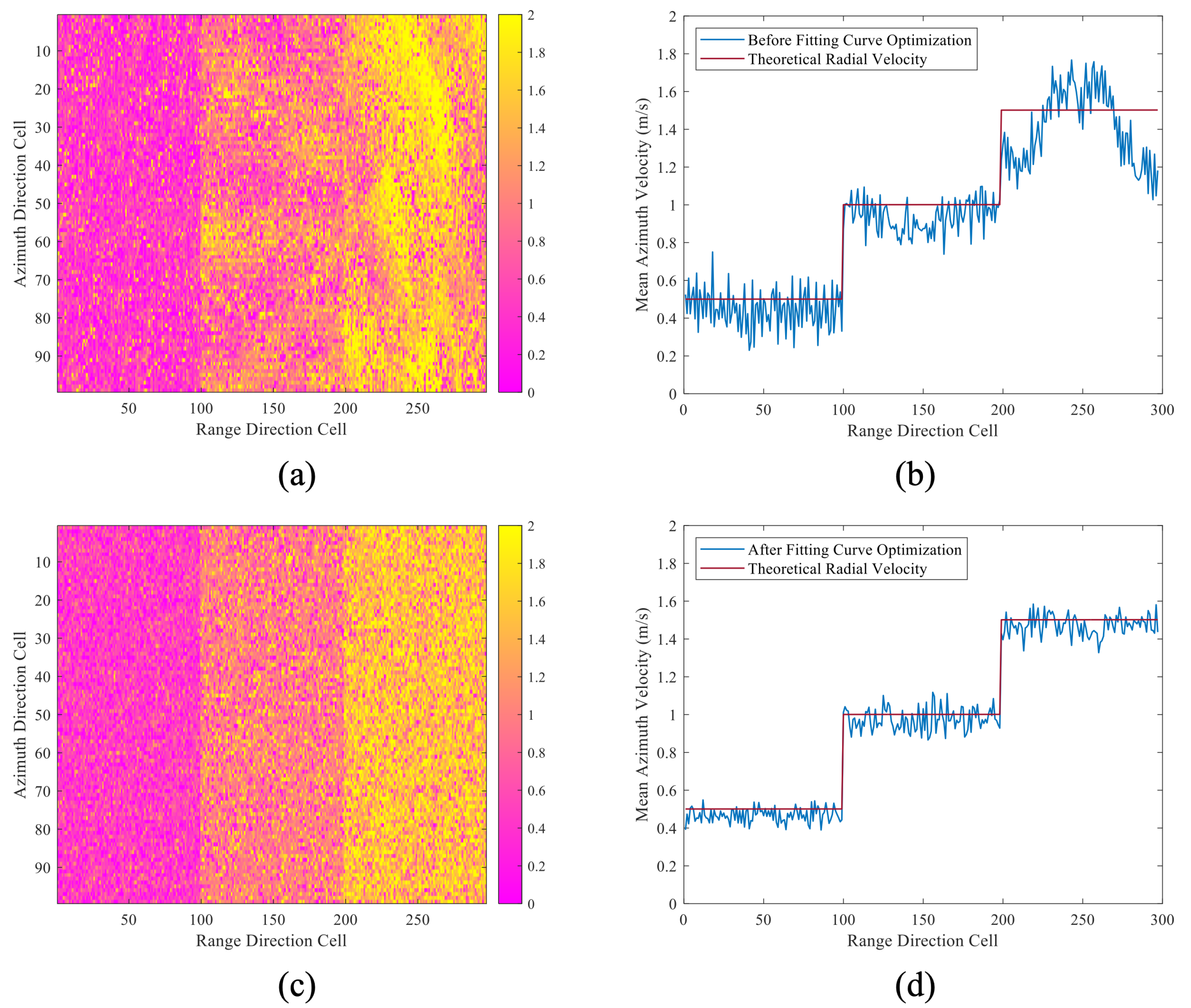

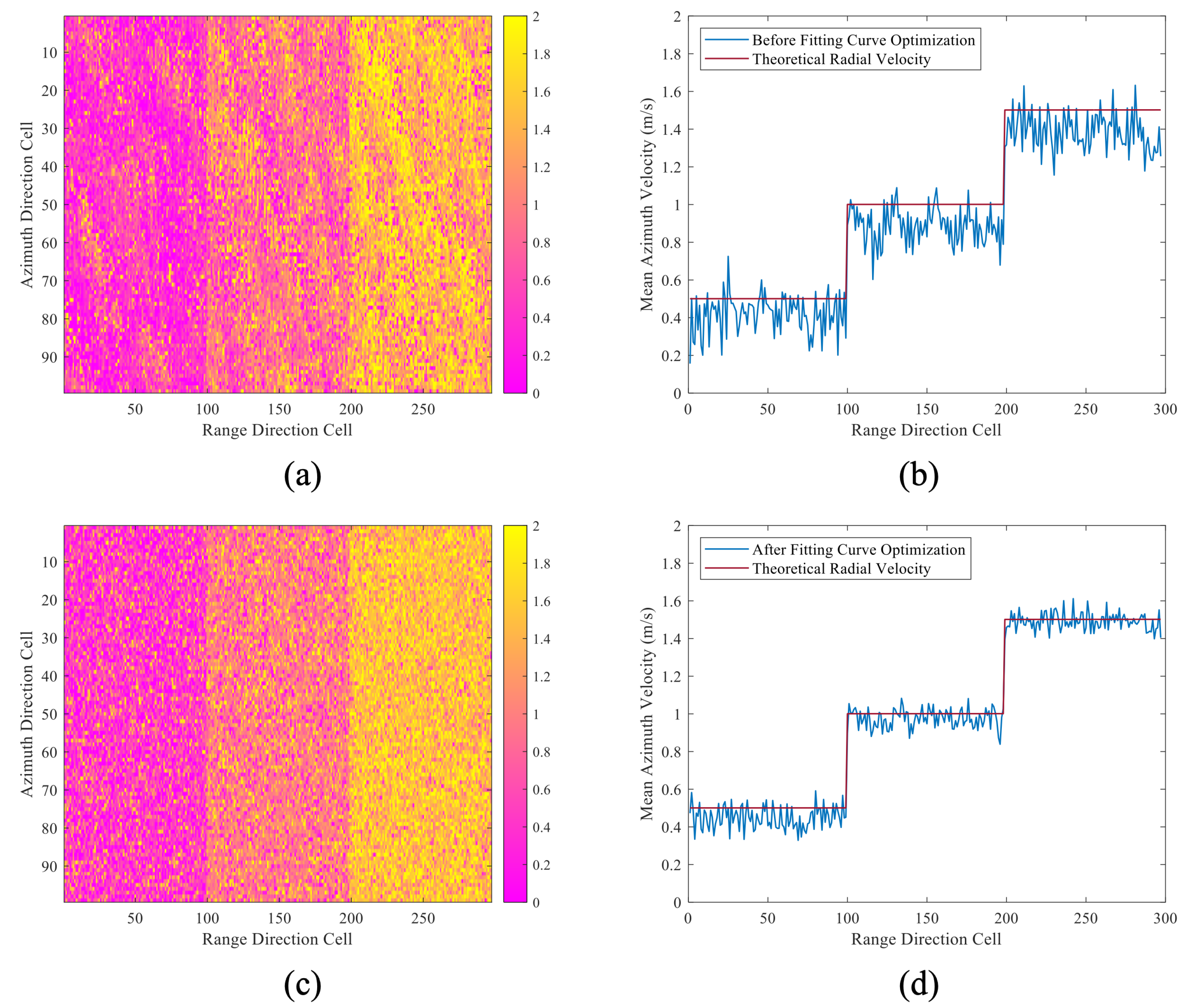
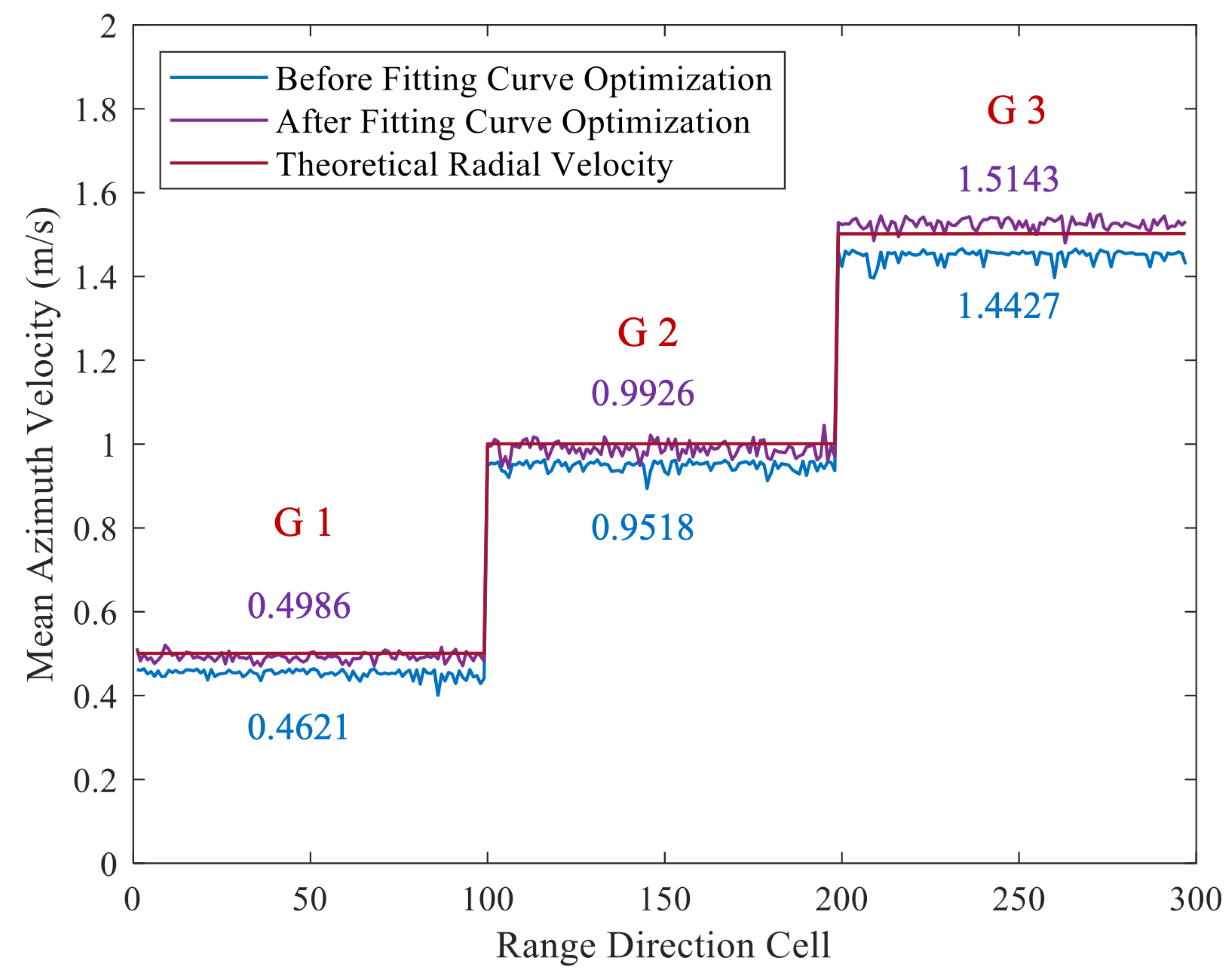
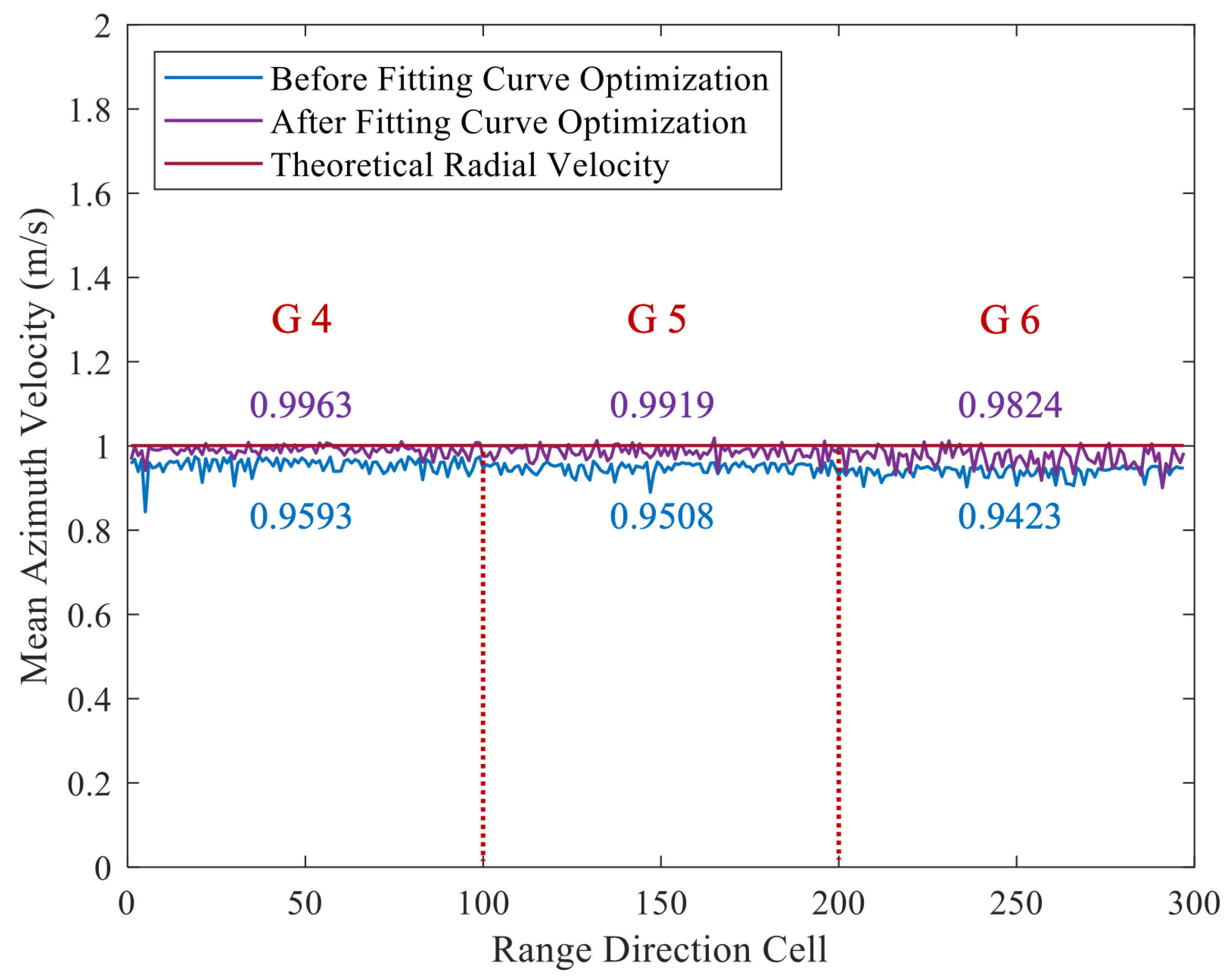
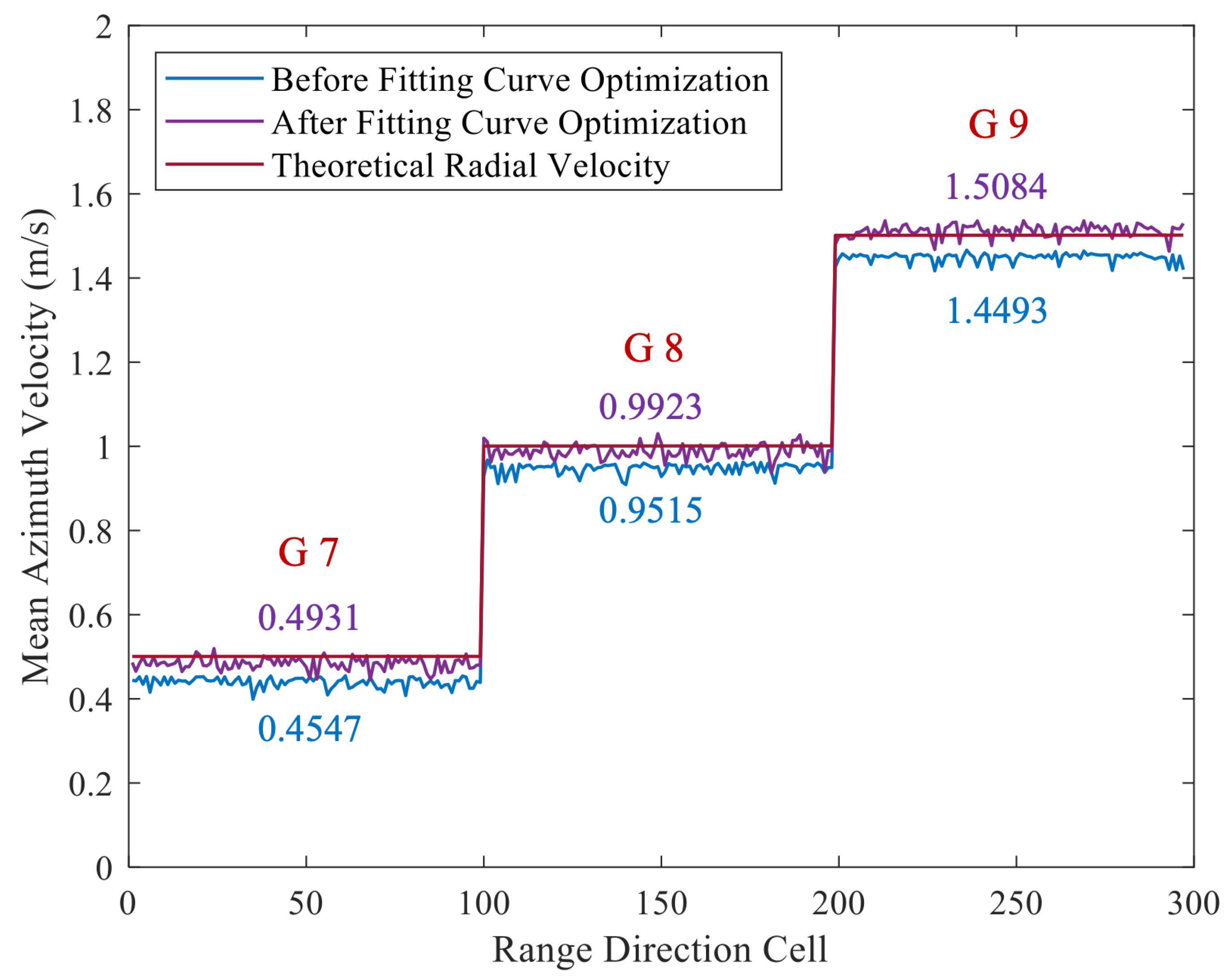
| System Parameter | Value | System Parameter | Value |
|---|---|---|---|
| Satellite velocity | 7700 m/s | Operating frequency | 9.65 GHz |
| Orbital altitude | 438.7 km | Bandwidth | 75 MHz |
| Incident angle | 35° | Effective along-track baseline length | 5.4645 m |
| Range sampling points | 3290 | Sampling rate in range direction | 90 MHz |
| Azimuth sampling points | 2637 | PRF | 4000 Hz |
| Squint angle | 3° | Receiver noise figure | 5 dB |
| Mean wave height | 0 m | Wind direction variance | 0.5 |
| System azimuth resolution | 2 m | System range resolution | 2 m |
| Azimuth BP grid resolution | 2 m | Range BP grid resolution | 2 m |
| Azimuth ocean surface grid resolution | 2 m | Range ocean surface grid resolution | 2 m |
| Simulated ocean surface range | 500 m × 500 m | BP imaging range | 490 m × 490 m |
| Experimental Group | 1 | 2 | 3 | 4 | 5 | 6 | 7 | 8 | 9 |
| Wind direction (°) | 45 | 90 | 135 | 45 | 45 | 45 | 135 | 135 | 135 |
| Wind speed (m/s) | 5 | 10 | 15 | 5 | 10 | 15 | 10 | 10 | 10 |
| Radial ocean current velocity (m/s) | 0.5 | 1.0 | 1.5 | 1.0 | 1.0 | 1.0 | 0.5 | 1.0 | 1.5 |
| Theoretical Radial Velocity (m/s) | Interferometric Phase (°) | Inversed Radial Velocity (m/s) | Inversion Error (m/s) |
|---|---|---|---|
| 0 | −0.0003 | 0.0002 | 0.0002 |
| 0.3046 | −0.0875 | 0.2901 | −0.0146 |
| 0.6092 | −0.1827 | 0.6056 | −0.0037 |
| 0.9138 | −0.2695 | 0.8940 | −0.0198 |
| 1.2185 | −0.3657 | 1.2121 | −0.0064 |
| 1.5231 | −0.4509 | 1.5047 | −0.0184 |
| 1.8277 | −0.5493 | 1.8206 | −0.0070 |
| 2.2023 | −0.6323 | 2.2159 | −0.0136 |
| Experimental Group | Iteration Round | RMSE before Divergence |
|---|---|---|
| 1 | 7 | 0.0936 |
| 2 | 7 | 0.1147 |
| 3 | 9 | 0.1524 |
| 4 | 7 | 0.0968 |
| 5 | 8 | 0.1278 |
| 6 | 9 | 0.1497 |
| 7 | 7 | 0.1136 |
| 8 | 7 | 0.1157 |
| 9 | 7 | 0.1185 |
| Experimental Group | Iteration Round | RMSE before Divergence |
|---|---|---|
| 1 | 5 | 0.0913 |
| 2 | 6 | 0.0968 |
| 3 | 7 | 0.1153 |
| 4 | 5 | 0.0932 |
| 5 | 6 | 0.0824 |
| 6 | 8 | 0.1121 |
| 7 | 5 | 0.0899 |
| 8 | 5 | 0.0913 |
| 9 | 5 | 0.0967 |
Disclaimer/Publisher’s Note: The statements, opinions and data contained in all publications are solely those of the individual author(s) and contributor(s) and not of MDPI and/or the editor(s). MDPI and/or the editor(s) disclaim responsibility for any injury to people or property resulting from any ideas, methods, instructions or products referred to in the content. |
© 2024 by the authors. Licensee MDPI, Basel, Switzerland. This article is an open access article distributed under the terms and conditions of the Creative Commons Attribution (CC BY) license (https://creativecommons.org/licenses/by/4.0/).
Share and Cite
Min, Z.; Yan, H.; Jiang, X.; Chen, X.; Zhou, J.; Zhu, D. Research on Digital Twin Method for Spaceborne Along-Track Interferometric Synthetic Aperture Radar Velocity Inversion of Ocean Surface Currents. Remote Sens. 2024, 16, 3739. https://doi.org/10.3390/rs16193739
Min Z, Yan H, Jiang X, Chen X, Zhou J, Zhu D. Research on Digital Twin Method for Spaceborne Along-Track Interferometric Synthetic Aperture Radar Velocity Inversion of Ocean Surface Currents. Remote Sensing. 2024; 16(19):3739. https://doi.org/10.3390/rs16193739
Chicago/Turabian StyleMin, Zhou, He Yan, Xinrui Jiang, Xin Chen, Junyi Zhou, and Daiyin Zhu. 2024. "Research on Digital Twin Method for Spaceborne Along-Track Interferometric Synthetic Aperture Radar Velocity Inversion of Ocean Surface Currents" Remote Sensing 16, no. 19: 3739. https://doi.org/10.3390/rs16193739
APA StyleMin, Z., Yan, H., Jiang, X., Chen, X., Zhou, J., & Zhu, D. (2024). Research on Digital Twin Method for Spaceborne Along-Track Interferometric Synthetic Aperture Radar Velocity Inversion of Ocean Surface Currents. Remote Sensing, 16(19), 3739. https://doi.org/10.3390/rs16193739







